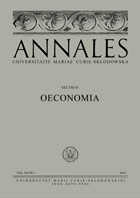Financial Standing of Selected Enterprises in the Polish Meat Industry – Original Research
Financial Standing of Selected Enterprises in the Polish Meat Industry – Original Research
Author(s): Chrystian Bernard Firlej, Krzysztof FirlejSubject(s): National Economy, Business Economy / Management, Agriculture
Published by: Wydawnictwo Naukowe Uniwersytetu Marii Curie-Sklodowskiej
Keywords: meat industry; financial standing; discriminant analysis; WIG Food; COVID-19 pandemic;
Summary/Abstract: Theoretical background: The present research is founded on three motives: (1) an analysis of the Polish meat industry from 2014 to 2022 considering development barriers in that period; (2) an analysis and as- sessment of the financial standing of selected enterprises in the meat industry from the WIG Food index; (3) verification of the effectiveness of the employed discriminant analysis models to predict bankruptcy of the companies of interest.Purpose of the article: The research objective was to assess the financial standing and the risk of bankruptcy of selected meat enterprises from the WIG Food index from 2014 to 2022. Research methods: Four multiple discriminant analysis models were employed to assess the potential risk of bankruptcy of the companies and verify their financial standing: Hadasik’s model, Model Z6 by the Institute of Economics of the Polish Academy of Sciences (INE PAN), Model Z7 by the INE PAN, and the so-called Poznań model. In an attempt to expand the analysis, we calculated the current ratio, which reflects the company’s ability to make payments with its current assets. The sample consists of Polish meat companies listed in the WIG Food index in all quarters of 2014–2022. Data for the analyses come from the annual accounts of the investigated organisations. The methods were supplemented with a literature search on multiple discriminant analysis.Main findings: The results demonstrate that the number of variables included in a discriminant analysis model does not determine its performance. The models can warn of potential financial problems in the companies somewhat in advance. However, none of the models exhibited any substantial sensitivity to the risk of bankruptcy for the analysed organisations. Two of the models (Z6 by the INE PAN and Z7 by the INE PAN) give very similar results because of significant design similarities. The research advances the state of the art regarding the application of multiple discriminant analysis to assess the risk of bankruptcy and financial standing of meat enterprises in Poland.
Journal: Annales Universitatis Mariae Curie-Skłodowska, Sectio H Oeconomia
- Issue Year: LVIII/2024
- Issue No: 1
- Page Range: 79-94
- Page Count: 14
- Language: English

